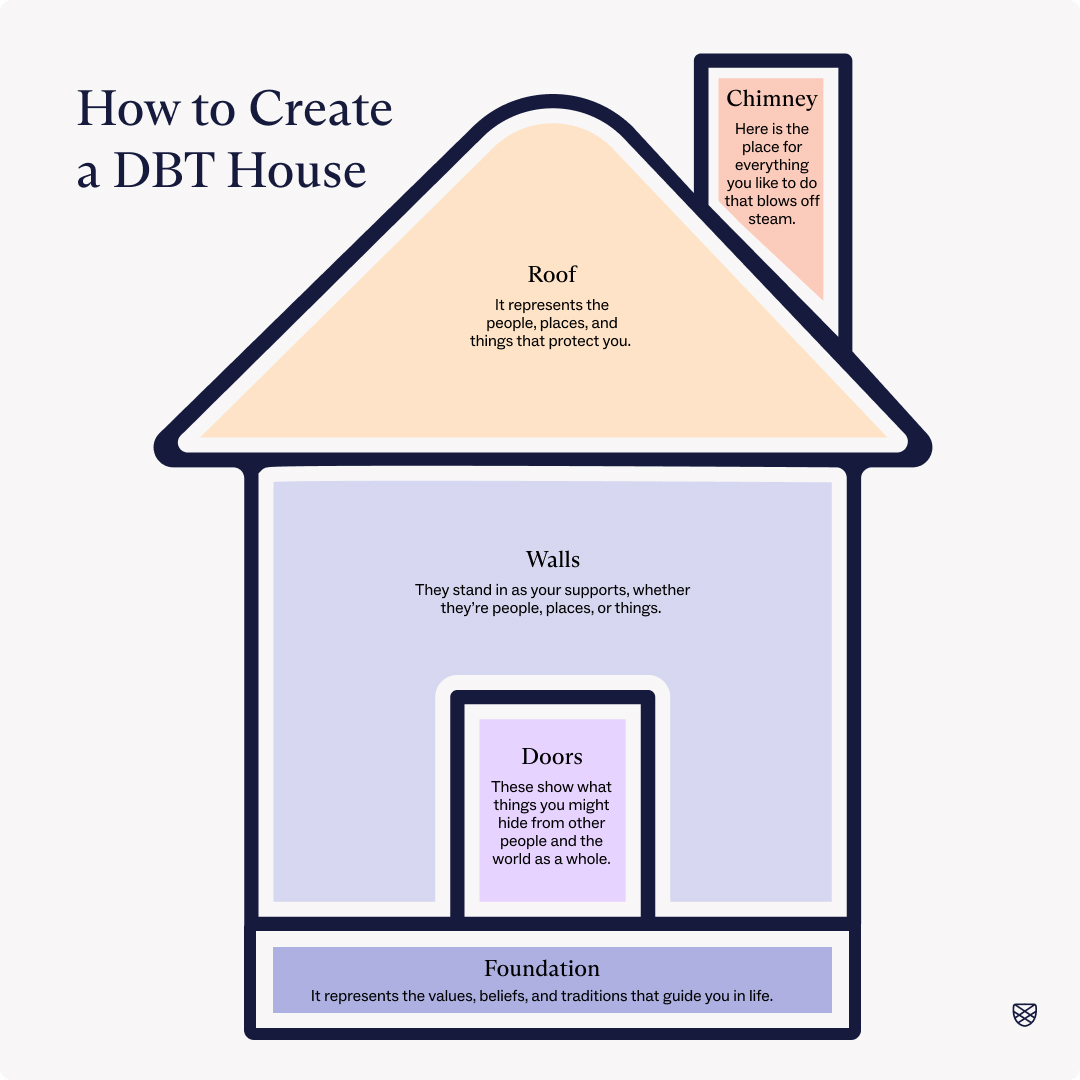
Table of Contents
Here’s How to Make a DBT House, According to Experts

Written By: Sarah Fielding

Clinically Reviewed By: Meghan Jensen
December 4, 2024
4 min.
A DBT house can be used as part of dialectical behavior therapy. Here’s how mental health therapists say a DBT house can benefit you and your mental health.
Learn more about our Clinical Review Process
Table of Contents
One of the wonderful things about therapy is that it’s not one-size-fits-all. What works for one person won’t necessarily work for another, which is why there are a range of coping mechanisms and therapeutic techniques to try—from meditation and journaling to cognitive behavioral therapy (CBT) and mindfulness-based therapy.
In dialectical behavior therapy (DBT), a type of talk therapy geared toward people who feel their emotions strongly in daily life, one popular technique is the “DBT house.” This exercise gives you a clear idea of what makes you you, what supports you, and what triggers you. Below, experts delve into what the DBT house is, how it can support emotional regulation, and who the therapy benefits in general.

Learn skills to manage your mental health
Virtual, intensive therapy and DBT skills groups.
What is the DBT house?
The DBT house is one of many exercises taught in DBT — a skills-focused therapy that teaches people concrete exercises to manage certain behavioral and mental health symptoms and disorders. DBT skills commonly center around mindfulness, distress tolerance, interpersonal effectiveness, and emotional regulation. “DBT encourages people to learn and use mindfulness training in practical ways,” says Charlie Health Clinical Supervisor Tracye Freeman Valentine, LPC-MHSP.
So, where does the DBT house fit in? “A DBT house is a therapeutic tool used as a visual representation of a house with levels and rooms representative of a person’s life, values, emotions, and relationships,” says Freeman Valentine. “Represented in the house are stages of skill development and emotional regulation, which allow individuals to easily visualize their journey towards recovery and identify areas where they need to focus on improving their skills.”
How to create a DBT house
To make a DBT house, you will need two things: a blank piece of paper and a writing utensil. To start, all you have to do is draw a house. It needs to have a foundation, walls, door, roof and chimney, with each part representing a different aspect of your life. Here’s how Charlie Health Group Facilitator Clary Figueroa, MSW, suggests thinking about each part of the house:
- Foundation: It represents the values, beliefs, and traditions that guide you in life.
- Walls: They stand in as your supports, whether they’re people, places, or things.
- Doors: The doors show what things you might hide from other people and the world as a whole.
- Roof: It represents the people, places, and things that protect you.
- Chimney: Here is the place for everything you like to do that blows off steam.

You can also put a billboard by your house — whether or not it would traditionally be there, says Figueroa. The billboard is a place for laying out all your accomplishments, skills and traits that you want to put out in the world.
“A DBT house brings attention to strengths and supports in your life while highlighting areas to grow,” says Figueroa. “Bringing this information into the open and putting it on paper allows you to better understand yourself. If you understand yourself, you will be able to help others understand you as well.”
Figueroa explains that this house should represent you, so as long as you include these key points, you can be creative and express yourself with the drawing. If you want to add a personal flare to the house, then feel free to use additional tools like colored pencils.
“If there is something in your house that you do not like, remember you have the power to change it,” says Figueroa. “This can help you reflect on areas of your life and enact change where you want it.” She adds, though, that making change isn’t something you are expected to do alone, and recommends looking into groups to join DBT programs pursuing DBT treatment with a trained mental health professional.

Who can benefit from DBT?
DBT was initially created for people with borderline personality disorder, but many individuals can benefit from the therapy. “Someone may want to explore DBT if they really want to learn skills to help them with regulating their emotions, managing crises, practicing mindfulness, and wanting to learn tools to help them communicate effectively,” explains Figueroa. During DBT therapy sessions, people typically learn DBT skills, create coping strategies for daily life, and explore any mental health symptoms they are experiencing.
Figueroa adds that DBT can specifically benefit people living with conditions such as:
- Eating disorders
- Substance use disorders
- Struggles around self-harm
How Charlie Health can help
If you or a loved one are struggling with your mental health, Charlie Health is here to help. Our virtual Intensive Outpatient Program (IOP) provides more than once-weekly treatment for people dealing with serious mental health conditions. Our expert clinicians incorporate evidence-based therapies, like cognitive behavioral therapy and dialectical behavior therapy, into individual counseling, family therapy, and group sessions. With this kind of holistic treatment, managing your mental health is possible. Fill out the form below or give us a call to start your healing journey today.




